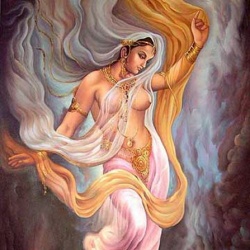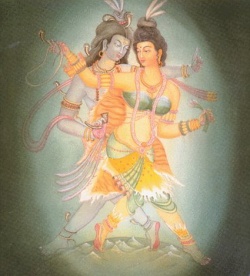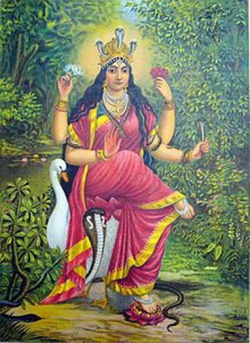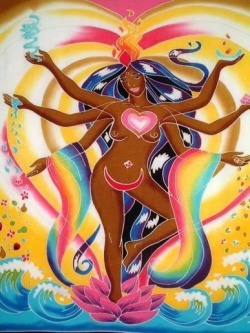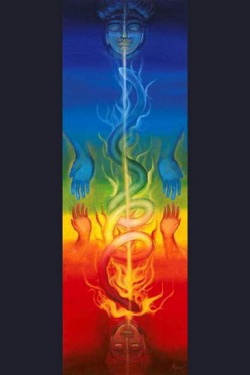Shakti
When Brahma created the universe, the Primordial God was divided in two directions:
· Masculine : “Sadha Shiva = the masculine aspect”, or the light which comes from the Sun to warm the Earth.
· Feminine : “Adi Shakti = primordial energy”, hich created the Universe and the Earth.
When the Universe began, the Goddess was alone. From her was born everything beautiful and everything that had energy.
The body is inert without the breath of life, but the goddess Shakti is life, the will and power which animate the eternal gods. She possesses the principle necessary for development of the cosmic embryo (the egg from which Creation was born). An invisible
spiritual entity, Shakti is the force behind Shiva, Vishnu, Brahma and even the apparent rebirth of nature in the spring. This force is the substance of all and is omnipresent. As a cohesive force, Shakti is the wisdom and conscience of Krishna, the immensity of Brahma and the feminine Yoni of Shiva.
Through his union with this energy, Shiva- the Eternal Lord of Sleep, can become the active, fertile principle. The feminine driving force, Shakti is the necessary complement to the divine masculine force of SHIVA. She initiates creation and procreates.
Thus speaks the Great Goddess in the Devi-sukta of the Rig-Veda (Hindu Holy Scripture: ” I am the kingdom which gives prosperity to all. I know all and my empire is immense. The gods have given me numerous dwellings and I live everywhere (Devi-sukta of the Rig Veda). From me is born everything that eats, sees, breathes and hears. Those who ignore me are destroyed, so meditate carefully on what I
say: I am the joy of the gods as well as of men. I can give everyone that which he desires, I fight for the people, I am present in the earth and sky and give birth to the father. ” (Rig-Veda) (http://members.tripod.com/historel/orient/14inde.htm) Shakti is translated as “Cosmic Energy.” Tantric doctrine stipulates mortal women are “life-itself” and Goddess-like, because they embody the principle of Shakti.
The sages “hold women in great esteem and call them Shaktis and to ill treat a Shakti, that is, a woman, is a crime.”
The final union with Shakti occurs at the moment of death, according to the Tantric mystics. She was both the individual and the
cosmic goddess absorbing the body and soul of the dying sage into herself, an experience of unsurpassable bliss on his part. “The possession of her, the cosmic Shakti, the living embodiment of the principle of beauty and youth eternal, is the ultimate quest, the very highest prize.”In Hinduism, for accuracy it should be noted, Shakti means
eternal and Supreme Power, variously described as manifest energy, and substance of everything, and all-pervading. In the Vedas the term means energy. Presently Shakti is both connected with and identical to the power of the gods Shiva, Vishnu, or Brahma, the great Hindu triad. From the most ancient Hindu scriptural times Shakti, under a variety of names, is linked to Shiva, the Lord of
Sleep (and his various guises, especially Rudra). Shiva is said to be helpless without the divine energy, Shakti. The two, coupled in sexual union, are the two inseparable forces that impregnate the universe with life in all of its forms. Without Sakati, Shiva is merely the Void. “He has no visible form,” the Linga-arcana Tantra states. The Goddess is the source of all, the universal Creator. Shakti
does not even need Shiva; as eternal Virgin (Kumari) she does not depend on any one’s power, for she is the One Itself as Power.
==A Hindu-Buddhist Distinction==
Dakinis, goddesses and/or female consorts of deities in Buddhism are viewed as embodiments of Wisdom. This contrasts starkly with the Hindu tradition, which views female deities as aspects of energy called Shakti. In fact the Sanskrit word, shakti means power.
By the way, it is incorrect to think that there are 3 main gods in the Indian tradition. That was an idea imposed upon the structure of Indian mythology by scholars from the tradition that held to the Trinity paradigm.
In Bengal, Bihar and also in Nepal, the divine is understood, worshiped or invoked as a female. In Tibetan Buddhism, this confidence is most famously expressed in as the cult of Tara. It is not incorrect to view her and any of her manifestations as
deity, bodhisattva, dakini but also, especially in Nepal where Hinduism and Buddhism intertwine, as Shakti. It may surprise some people to find that in the tantric tradition, Buddha Shakyamuni is considered to have taken the dairymaid, Sujata, as a temporary tantric consort fulfilling the role of shakti.
In the biography of Ayu Khadro, we learn that it was not uncommon for people visiting the Vajrayogini shrine to also go to the Kali temple near it, and vice versa. (The Hindu goddess Kali is a very wrathful manifestation of Parvati, wife of Shiva.)
Tibetan Goddesses
S. Karmay enumerates 9 primordial females (srid pa mo dgu) who are sisters:
Ancestress Queen of the Sky, White Menmo of the Sky, Woman Who Does Not Talk, Female Tiger, She Who Develops and Strengthens, Sharp Flaming Point, She Who Rides a Deer, Queen of the Cha, White Goddess.
In transliterated Tibetan, he names these Nine Females of the World:
The Sky Queen is gnam-phyi-gung-rgyal. The second is gNam-sman-dkar-mo, the aunt of Gesar of Ling. The third sister is Mi-mkhan ma-mo who had the 8 offspring that are the progenitors of mankind. The 5th sister is Shed-za na-ma, the goddess of life whose four offspring are: pho-lha, ma-lha, zhang-lha, and sGra-lha. The 7th sister is phyva-tshe rgyal-mo (Queen of Wealth) and the mother of the gods, of horses, the door, and the hearth.
As a form of "enlightening" energy, the dakini could also be viewed as Shakti. This activity-that-empowers appears even in mystical Judaism [kabala] where she is Sh[e]kina, the glory of the Deity, but she is also the blessing that is the Sabbath Bride.
Shakti
The shakti of Hindu deity Shiva is the most widely recognized. She has many names, manifesting as do most goddesses, in 3 main forms:
The maiden, virgin or more usually, nubile like Parvati, wife of Shiva.
The Maiden aspect is the woman who serves to inspire the young hero on his quest. In folk tales, movies and video games, she is a princess.
2. mature, generous, fiercely protective and motherly Hindu goddess Devi or Uma, or an alternate form, 10-armed Durga (Beyond Reach,) the warrior who vanquished primeval evil in the form of a monstrous water buffalo. See a similar form of the Buddhist deity, Vajravarahi.
Read her hundred names for insight into tantric Buddhist female deities.
This is Isis, deity of ancient Egypt, in search of her lost husband, Osiris. This is also Demeter, Greek goddess of Asia Minor, seeking her daughter Persephone and confronting the Universal Host, Hades, Lord of Death, to bargain for her return.
3. The wrathful crone, Hindu black goddess Kali (remember Indiana Jones and the Temple of Doom?) is garlanded with skulls. The Sanskrit word, kali can be understood both as time and as black. She is the avenger of evil, and her sixteen hands hold various weapons symbolic of forms of destruction. She is surrounded by a ring of flames, and from her fanged maw protrudes her red tongue.
At her death, once every god-year [365 of ours], Shiva collects one of her bones to add to his mala which currently comprises only 21 bones. Animals (usually black goats) still are sacrificed at her temples like Kalighat, in Calcutta and therefore she is not a suitable object of Buddhist devotion. It was only in 1780 that human sacrifice was outlawed, though it had already been restricted as far back as Vedic times.
Kali also manifests as Chinnamasta, who bears her own severed head. There is a similar form in Tibetan Buddhism. (The motif in its male, Celtic version appears in the old poem Sir Gawain and the Green Knight. )
In many mythologies, the goddess disguises herself as an old woman and, in this manner, gets invited into the palace. There she performs helpful deeds that appear horrifying at first glance, for example, Greek goddess Demeter's attempt to bless the son of Metaneira by "burning away his mortality" in the hearth fire.
Surya-chandra-siddhi
Her name is Sanskrit for Power of the Sun and Moon. She was a wisdom dakini that initiated Padmasambhava, and we read in the Nyingma text, Padma Kathang, that he prostrates to the enthroned dakini begging her for teachings: outer, inner and secret. She is called Laygyi Wangmo or "Queen of Action," for she transmutes her new acolyte by turning him into the sacred syllable HUM, swallowing him up and passing him
through her body. In that way, he is initiated into her teachings, obtaining her own magical power or shakti energy before being ejected through her " secret lotus," so that he is completely purified and transformed.
Even her handmaid or Kumari (Sanskrit: princess, maiden) was a sorceress. She cut open her own breast with a crystal dagger and displayed a glowing mandala of deities within her. The two dakinis lived in the Castle of Skulls.
Shacha Dema (Belmo, Sakya Devi) is the name of the Bhutanese girl who was a consort of Guru Rinpoche's and is thought of as an emanation of Vajravarahi. She is depicted as the tigress in tangkas of his wrathful form as Dorje Drolo.
==Yoginis==
Niguma and Nairatmya are both legendary yoginis (female adepts) embodying that extraordinary shakti energy. The first one is a lineage guru (11th century) in her own right, a mahasiddha and companion of Naropa. She taught what is known as The [[Six Yogas
of Niguma]] which includes abilities such as tummo, the practice of generating heat.
The second whose Sanskrit name describes her as Absolutely-No-Self, is the consort of Marpa, his moderating influence and the mentor of Milarepa.
Khyungpo Naljor Meets the Dakini Niguma:
An extract from the life story of Khyungpo Naljor in the Golden Rosary, Lives of the Shangpa Kagyu Masters (Shangs pa gser 'phreng) translated from the Tibetan by Nicole Riggs, to be published soon.
With five hundred ounces of gold on him, Khyungpo Naljor traveled throughout the four corners of India, meeting lamas and asking who had actually seen the Buddha. All panditas and siddhas said the same thing: Naropa’s sister [some say, consort) Niguma, who dwelt in the three pure states, had received the Dharma directly from Vajradhara.
They all also said that no matter where one is, if one has sacred outlook, one will be able to see her face. But if one’s outlook is impure, she won’t be found no matter how hard one looks. Niguma truly dwelt in a pure state and possessed the rainbow body. Khyungpo was told that she could be seen
frequently in the great charnel ground of Kosaling with her entourage. Just hearing the name of the dakini made Khyungpo weep and his hair stand on end. He felt overwhelmed with devotion and immediately left for the
charnel ground of Kosaling repeating the mantra Namo Buddha on the way.
Suddenly, the dakini appeared in the sky in front of him, at the height of about seven palm-trees, her body red-brown in color. She was wearing bone ornaments. In her hands, she held a skull-cup and hooked knife. She was dancing and displaying one and many forms.
As soon as he saw her, Khyungpo thought, ‘This is the dakini Niguma.’ He prostrated and made several circumambulations. Then he knelt down and asked for the pure oral instructions.
But Niguma shouted: ‘Hey, you, watch out! I am the cannibalistic flesh-eating dakini. HA! Flee now! As soon as my retinue comes, we will devour you!’
In response, Khyungpo simply made more prostrations and circumambulations and once again knelt down, requesting the secret oral instructions.
Niguma now said: ‘So you really want the mahayana oral instructions?! Well, you’ll need some gold for that. Have you got any?’
At this, Khyungpo presented his five hundred ounces of gold. But the dakini grabbed the gold and hurled it in the air, scattering
it all over the forest. Seeing this, Khyungpo thought, ‘Oh, she really must be a cannibal flesh-eating dakini. She doesn’t even care for my gold!’
The dakini’s eyes darted about left and right, and her immeasurable retinue of dakas and dakinis appeared from the sky. Some in a flash created three-tiered heavenly mansions, some built up mandalas of colored sand, and others gathered the implements for a feast offering.
On the evening of the full moon, the dakini Niguma bestowed upon Khyungpo the empowerments of dream yoga and illusory body.
Next, she said, ‘Hey, little monk from Tibet, come on up here!’ By means of the dakini’s magical ability, Khyungpo rose in the sky to a height of about three yojanas. He found himself sitting on a golden mountain. Above his head, the dakini’s retinue was performing the mystical dance of the
tantric feast, and from the four sides of the mountain flowed four rivers of gold.
Khyungpo looked down at the streams of gold and asked, Does such a golden mountain really exist in India, or did the dakini make it appear?’
The dakini sang:
Whirling in the ocean of samsara
Are the myriad thoughts of love and hate.
Once you know they have no nature,
Then everywhere is the land of gold, my child.
If upon all things, like an illusion
One meditates, like an illusion,
True Buddhahood, like an illusion,
Will come to pass, due to devotion.
Now, a dream will come to you through my blessings.
Indeed, Khyungpo had the following lucid dream: He had gone to the realm of gods and demi-gods. He was being eaten alive by some large demi-gods when the dakini appeared in the sky saying, ‘O son, do not wake up.’
At that very instant, he received the instructions on the six yogas.
After he woke up, the dakini appeared and said: ‘No one else in India has ever received the complete yogas in one session.’
The Triple Goddess
The dakini's triple nature is manifest in the Buddhist deity, Vajrayogini.
It was not by chance that Shakespeare used 3 witches or 'the three wyrd sisters' in his Scottish play, Macbeth. In European mythology, this three-fold nature appears as the three Norns or Fates who spin, measure and then clip the thread of life. Contemporary pagans or Wiccans also know
her as the Triple Goddess, ruler of the three times [[[Wikipedia:past|past]], present and future] and the three worlds (heaven, earthd].
- It is well-known that the Celts [pron.: kelts] were members of the same ancient cultural group as some of the ancient migrants to India. The cauldron of Celtic myth and folklore (the pot at the end of the rainbow) is the equivalent of the
dakini's skull-cup vessel, but in the European tradition it may be supported on a tripod, in which all substances, pure and impure, are mixed and transformed into bliss-ambrosia. It performs the same function as the bowl the dakini lifts to her lips or offers to others.
Trickster Energy
The Roma (Gitanos, Gypsies) acknowledge the Trickster aspect of shakti when they speak of duende, a spirit or force which enters through the feet causing a person to dance fiercely, or to be driven to extremes of behaviour, even madness. And this is not surprising, since it is thought that they originated in the central regions of India, today called Rajasthan.____________________________________________________________________________
Shakti: This Sanskrit word means "power," but it actually refers to a weapon such as a trident, pike or lance. In the symbology of many ancient gods, powers were depicted as tools and weapons; items that are collectively known today as "attributes." In some cultures, the
female form of Divinity is a kind of living attribute -- that is, the goddess-consort stands for the god's activity in our world.
Himalayan Buddhism also makes use of this "language," but more frequently it employs a subtler system that speaks of levels of "existence" in which Deity proceeds from Emptiness and is composed of Wisdom, depicted as a female in conjunction with Method as male.
